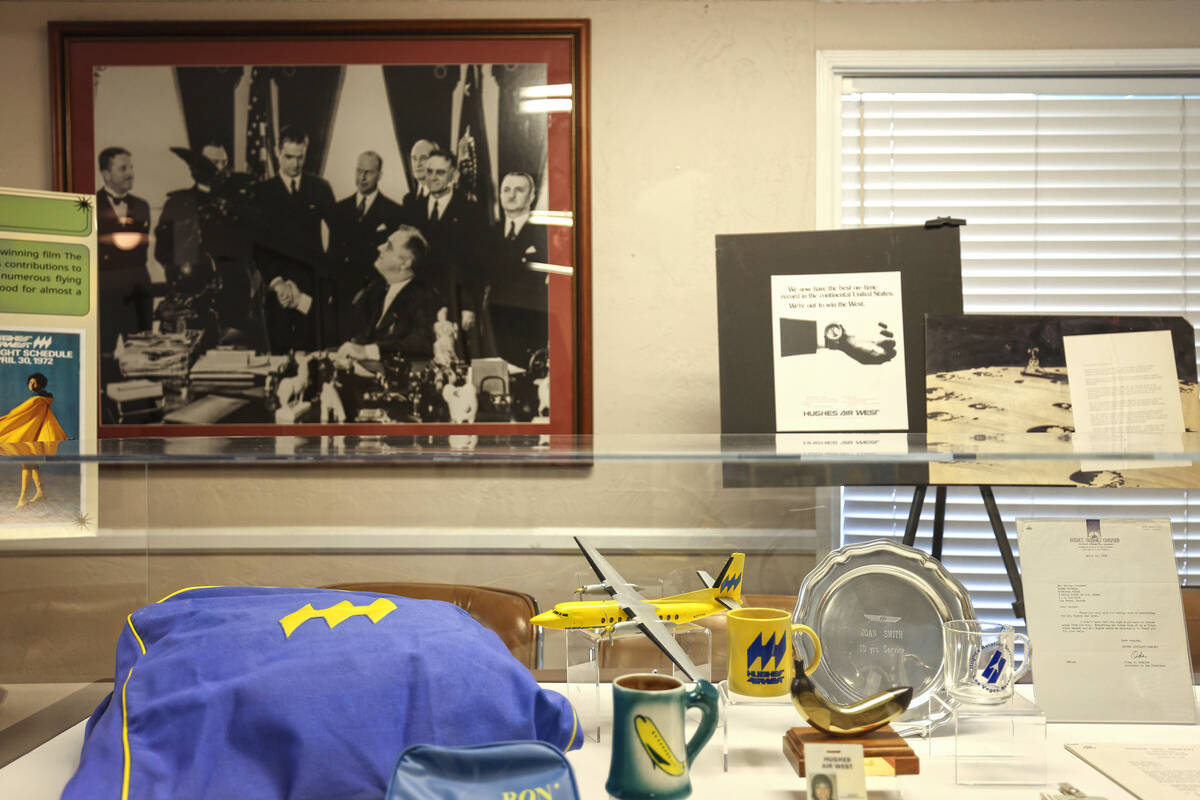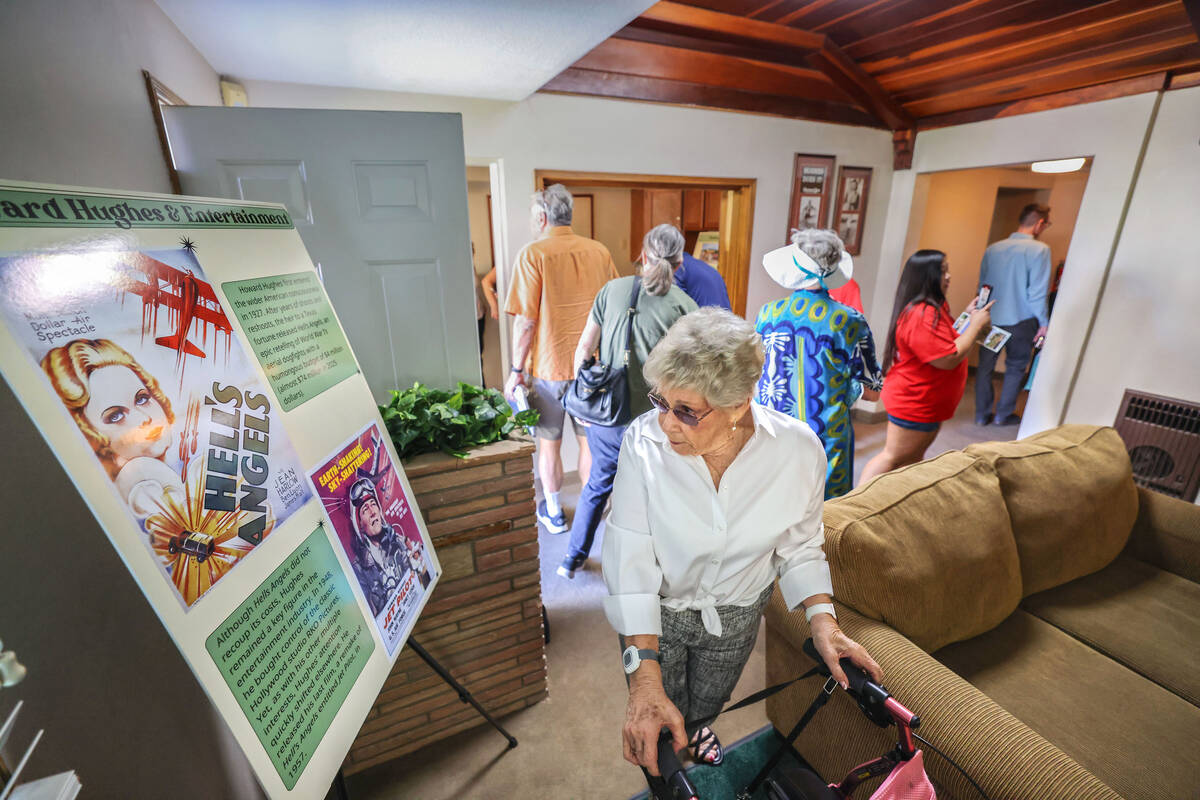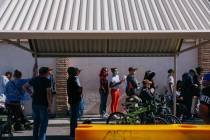Former Howard Hughes home to be relocated
A new effort is underway to help preserve and relocate a single-story bungalow once owned by Howard Hughes, the iconic Las Vegas real estate mogul, filmmaker and aviation pioneer.
Hughes’ former so-called “Green House,” at 3228 Channel 8 Drive in Las Vegas, currently sits about a quarter-mile from the Las Vegas Strip between East Desert Inn Road and Convention Center Drive. But that may soon change thanks to the Heritage in Motion fundraising project that would fund moving the structure from its current site where KLAS-TV is stationed to the Clark County Museum campus at 1820 S. Boulder Highway in Henderson.
The house was built sometime around 1950 and was leased by Hughes beginning in 1953, according to Michelle Munkres, chair of Heritage in Motion. Hughes ultimately lived there only for an estimated eight months, but used the home as an office, where friends reportedly saw him field defense contract calls and pore over ledgers for his production company, then called RKO Radio Pictures, Inc.
Following Hughes’ departure, the property was sealed off until after his death in 1976, Munkres said.
“Here, he was able to find privacy, conduct business and really begin his connection to Las Vegas, a place that in many ways would become central to his later life,” Munkres said of Hughes, who at one point also owned or was otherwise financially vested in the Desert Inn, the Sands, Frontier, Silver Slipper and Castaways. Munkres spoke before roughly 50 attendees during a kickoff event Wednesday hosted by Channel 8 and the Clark County Museum Guild — the fundraising arm of the Clark County Museum.
Representatives from KLAS reached out about four years ago to begin the process of donating the house, and agreed to donate it if the project proved to be viable, Munkres said. The guild paid for a feasibility study, which revealed relocating the structure to Henderson, restoring it and fleshing out an exhibit would come with a roughly $4.3 million price tag.
To date, the project has received a $1.2 million donation from longtime guild members Gary and Gayle Clinard, and the Clark County Commission in 2024 approved $1.5 million in public funding toward the project, leaving $1.6 million to fully pay for the endeavor, which is described on the guild’s website as a “once-in-a-generation effort” to preserve a mid-century piece of Las Vegas history.
Should the fundraising goal be met, the Hughes Green House will become one of the most noteworthy homes part of the museum’s “Heritage Street” exhibit, described by officials as a walkable timeline of structures built from the 1910s through the 1950s. Munkres said that to date, the Clark County Museum has moved 16 houses for its Heritage Street effort, and the addition of the Green House would help develop new programming centered around Hughes’ contributions to aviation and film history.
“We are going to ensure that this house and its history have its stories told for future generations,” Munkres said. “No one is better equipped to preserve and share those stories than the Clark County Museum.”
Work to prep the foundation and to physically relocate the Green House could be underway by 2028, according to an anticipated timeline from organizers of Wednesday’s event. Donors can contribute to ccmghugheshouse@gmail.com through the payment platform Zelle, or sponsorship levels will be available for donors seeking to provide between $10,000 and $500,000.
‘Part of our past’
It’s unclear when the Hughes house was actually erected, Munkres said, and Hughes biographers debate whether it was used as a dwelling in addition to a day office. Real property records from Clark County assessor’s office indicates the house was built in 1951, though a guild webpage about the Green House notes the structure appeared in aerial photos from 1950.
Regardless, according to a fact sheet provided Wednesday to attendees, the home was initially planned to be a model home for the planned Sun Villa Motel subdivision. The house was painted mint green with white trim and quickly became a local landmark. In 1968, Hughes purchased KLAS-TV, including the property in which the station and his Green House were situated, but continued to spend the majority at a private suite at the Desert Inn.
Hughes left abruptly one day in 1953 and ordered the house be sealed off, according to the museum. Hughes never returned, and the home was not reopened again until days after Hughes’ death in 1976 by staff of the Summa Corp., a business spinoff that controlled his casinos, television stations, airports and various real estate holdings, who were searching for Hughes’ will.
Those who opened the house discovered a nearly pristine 1950s interior, Munkres said. Cabinets, drawers and windows were taped shut and the chimney was boarded with plywood, but Hughes’ will remained elusive. The concrete floor at one point was broken up after it was suspected Hughes’ will may have been hidden it, but the museum notes online that a will has never been found.
“Since then, it’s just been part of our past,” KLAS-TV reporter John Langeler said. “It’s a part of our fabric, of course, because we work here, but it’s more a part of Las Vegas history. And I think that’s why this campaign is getting underway, to see what we see every day with the rest of Southern Nevada.”
Contact Casey Harrison at charrison@reviewjournal.com. Follow @Casey_Harrison1 on X or @casey-harrison.bsky.social on Bluesky.
























